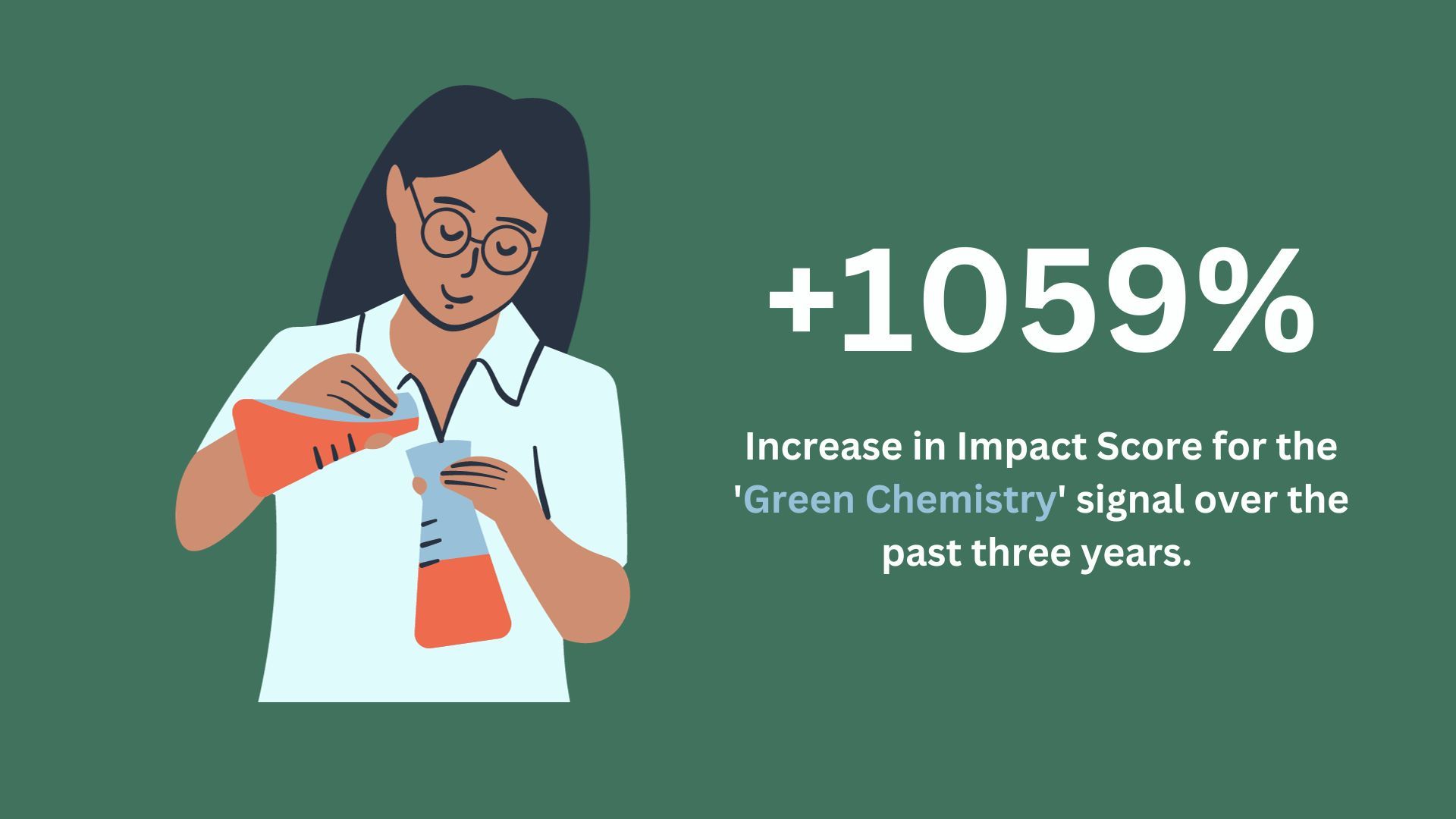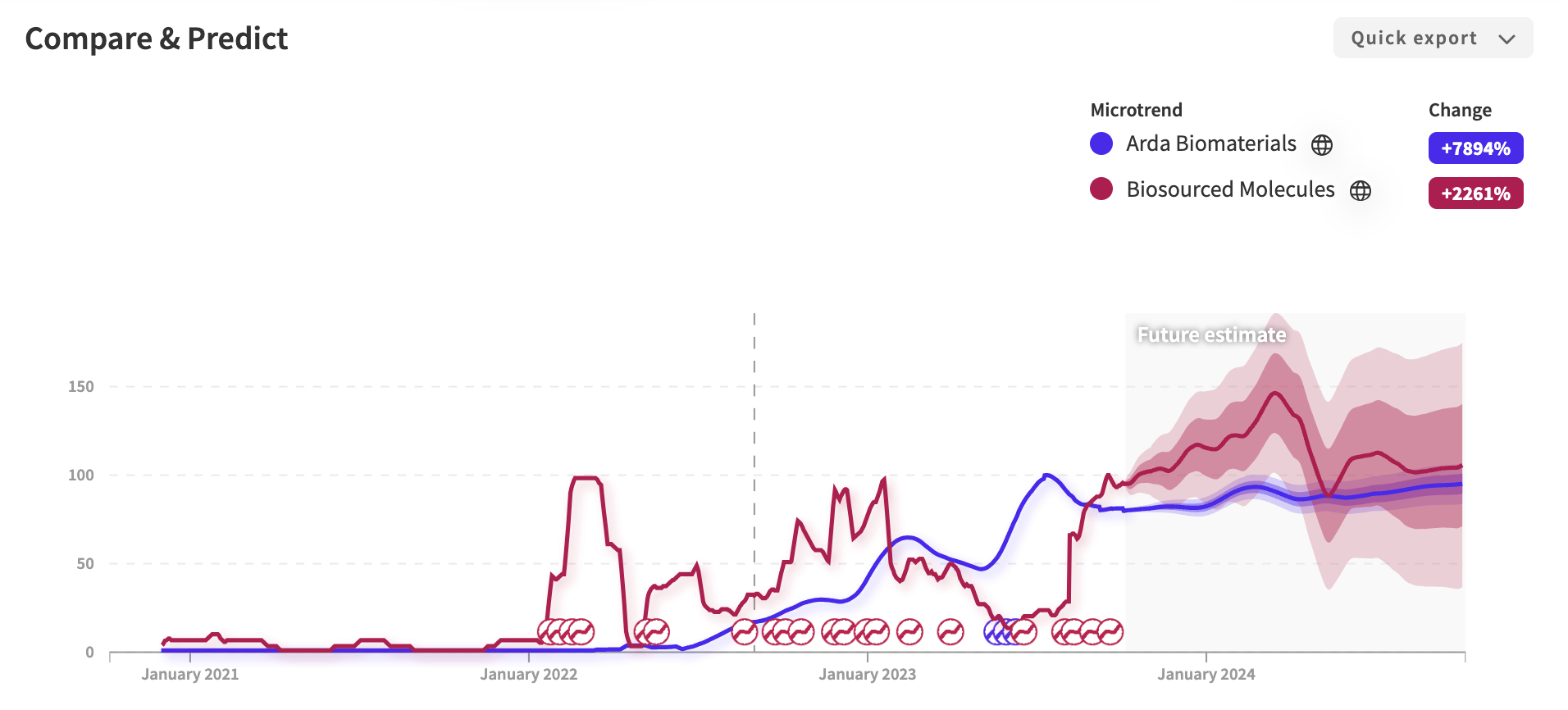Hello Forecasters,
Welcome back to the Inflection Point. The newsletter tracking 100 million consumer signals to predict cultural shifts relevant to you.
This week, we're covering 'Green Chemistry’
TLDR;
- Green chemistry offers companies an opportunity to reduce long-term risk.
- The most innovative companies are turning ‘waste’ into new materials.
- Brands that can story-tell chemical processes stand to gain.

What is 'green chemistry?'
Green chemistry is a chemical process that aims to remove negative environmental impacts.
From new industrial materials to pharmaceuticals, this production philosophy eliminates hazardous substances to minimize health risks for people and planet.
There are 12 principles of 'green chemistry'
but we'll cover just 6.
1. Prevention: it's better to prevent waste than to clean it up.
2. Atom economy: final products should maximize the incorporation of all materials used in creating them.
3. Less hazardous chemicals: generate substances with little to no toxicity.
4. Design for energy efficiency: minimize energy requirements and use renewable sources when possible.
5. Renewable feedstocks: use raw materials and feedstocks that are regenerative rather than depleting.
6. Design for degradation: create chemicals that can easily break down to prevent environmental pollution.
So, what are the green chemistry innovators creating?
1) Beer to Leather
In the typical process, raw barley grains are harvested to extract their sugars to make beer. The leftover materials are rich in protein and fiber and, until now, have been discarded.
Arda Biomaterials is giving barley waste new life by transforming it into materials for fashion and interior design. And since the barley is naturally dark, this ‘waste’ offers an alternative leather without the need for harmful synthetic dyes.

Most alternative leather companies are making their material from plastic. Instead, Arda’s process uses bio-sourced molecules, often referred to as bio-based materials, which are organic compounds derived from biological sources rather than fossil fuels.
The NWO.ai signal for ‘bio-sourced molecules’ is expected to see a sharp increase in conversation in 2024.
2) Potatoe to Textile
Fibe makes clothes from potato crop waste.
Cotton, polyester, wool, silk, and viscose comprise most of the world's textile supply.
All with significant environmental impact.
- The average T-shirt uses 2700 liters of water.
- Textile production uses up more than 2.5 of the world's arable land.
- The entire manufacturing process releases a ton of harmful chemicals and pollutants.
Current alternatives? Mostly made from plastic.
Fibe is the first company to use haulms (potato stems & stalks) to create fiber. Since haulms are difficult to compost and unsuitable for livestock food, farmers would historically let them rot in fields.
Fibe wanted to change that.
They partner with local sustainable farms and let them grow their potatoes as usual. Instead of going to waste, they collect the leftover stems, offering farmers a new revenue stream.
The result? A completely sustainable yarn made from a waste stream that can be used to make any clothing textile.
- No additional land
- 96% less water use
- 94% less pollutants and chemicals released
3) Fermentation to Natural Dye
Until the Industrial Revolution, we used natural dyes for textiles. Once synthetic chemicals were available, they outcompeted natural dyes in cost, scalability, and performance.
Colorifix is getting back to nature. Replacing chemistry with biology using biotech fermentation.
Their process:
- Find where a desired color exists in nature (e.g., blueberries).
- Identify and build DNA sequencing code to match the natural material.
- Engineer microbes that produce the color and then ship the living bacteria to a textile dye house.
- Companies grow microbes on-site to produce colors - which they can add to any standard dye machine.
Using natural processes, Colorifix has removed harmful chemicals from the dye process. Creating a water byproduct that is safe to enter oceans and streams.
4) Bacteria to Biodegradable Plastics
Genecis, is also using biotech fermentation to create a material with the same functionality as plastic without the pollution.
Their sustainable alternative to petroleum-based plastics can be used to replace:
- Clothing and textile (zero micro-plastic shedding)
- Single-use food and product packaging
- Automotive interiors
- Medical tools
5) Nanotech to Water-Proof Paper Packaging
Companies that attempt to use more sustainable packaging, such as those made from plants, often run into a big problem. Their packaging gets wet and can no longer be recycled, not to mention the pain for customers.
Cellulotech has developed a revolutionary nanotechnology that coats any paper product to prevent it from getting soiled.
- It’s 50X cheaper than traditional coating
- 92% less CO2 in the entire lifecycle
- Increases recycling potential

The NWO.ai signal comparison report below forecasts continued growth for the ‘Green Chemistry” signal in 2024.
Companies aiming to reduce supply chain risk associated with climate change are turning to biotech
'Synthetic' biotech is now widely accepted as a more sustainable means to produce raw materials. However, brands face consumer hesitancy due to the negative association with terms like 'lab-grown' or 'synthetic."
‘Green Chemistry' offers a new terminology that brands can begin to educate their consumers on. Helping internal operations become greener while shifting consumer perceptions of new chemical processes.
That's all we got for now.